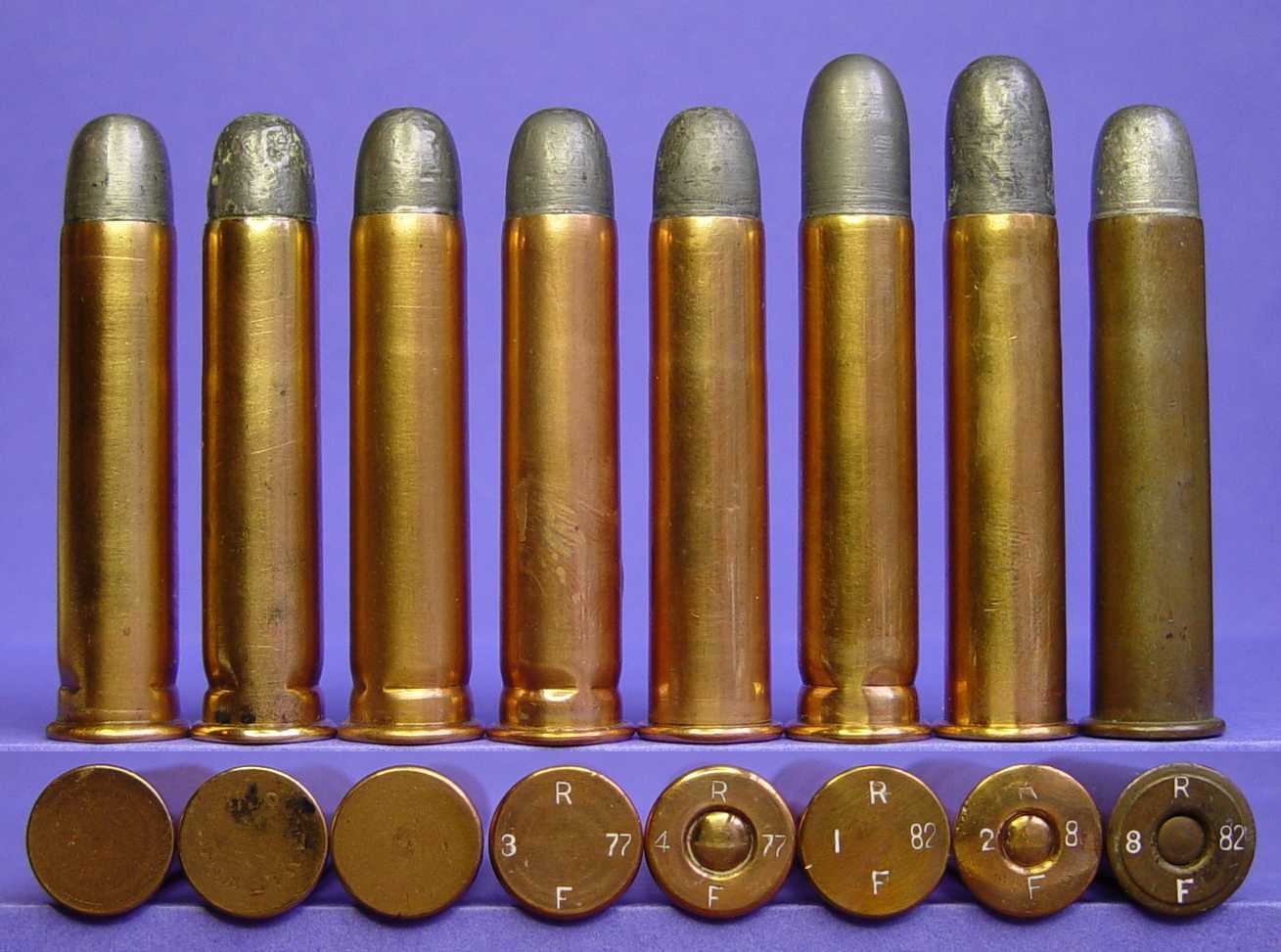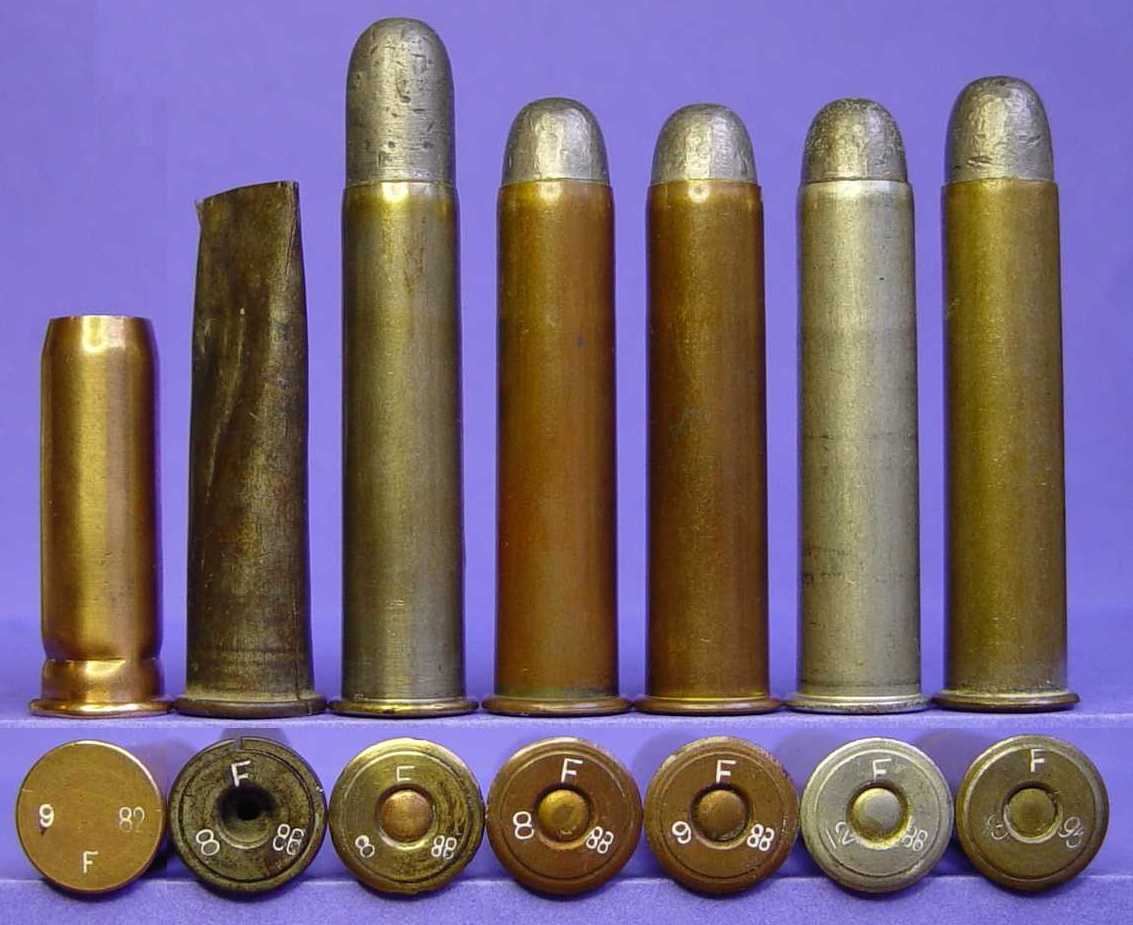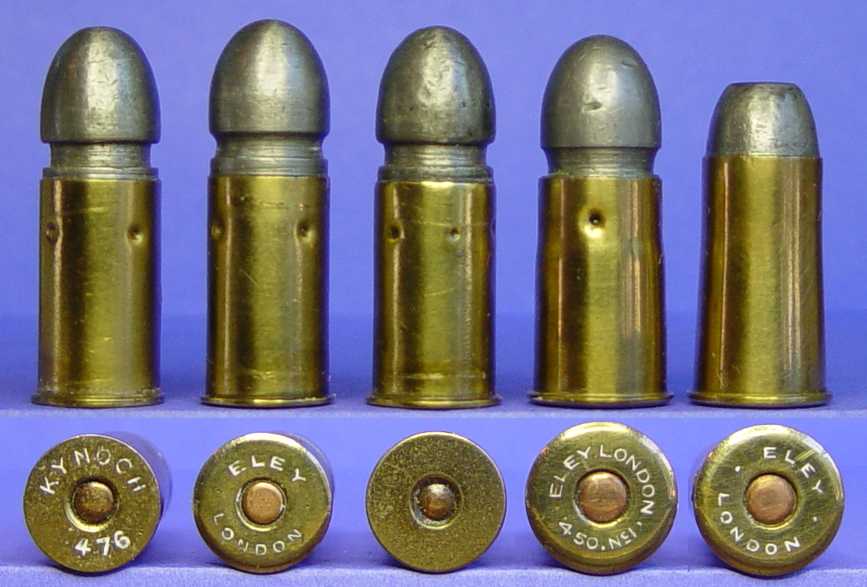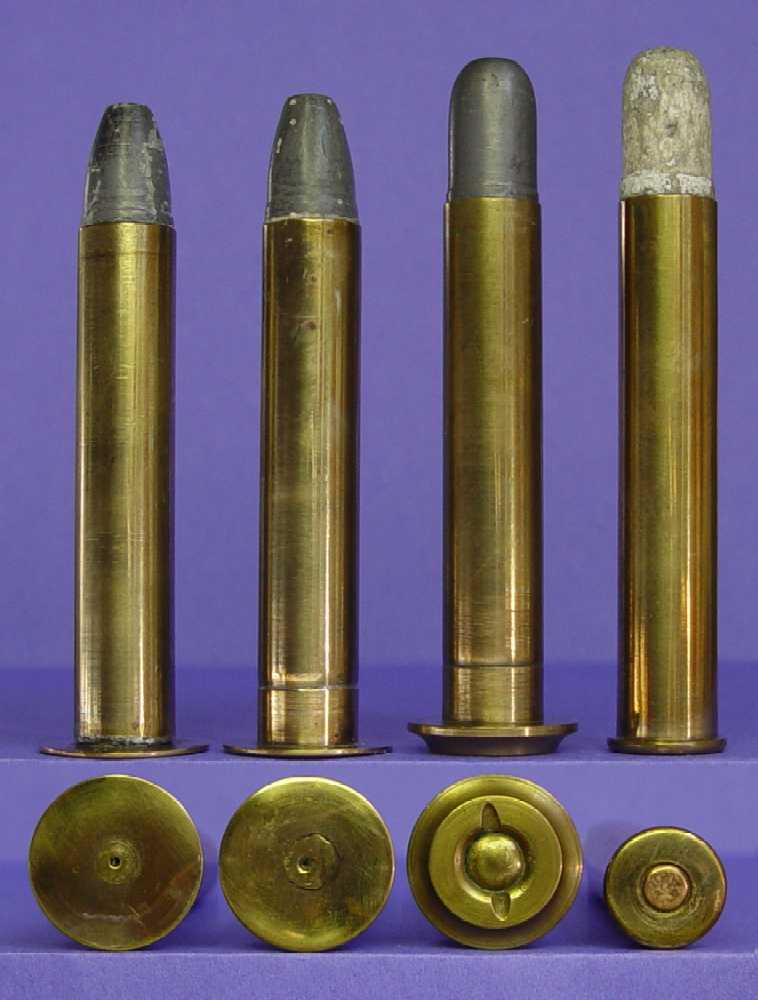|
THE CARTRIDGE COLLECTOR'S EXCHANGE |
| Contents
Cartridge
Lists
Prior Picture Pages:
Links to Other Sites
Cartridge Collectors Organizations:
Auctions:
Books:
Other Collector's Sites: |
Home of the Old Ammo Guy's Virtual
Cartridge Trading Table
Picture Page November 2004 A group of interesting .45 Government Cartridges....
#2 - Raised US CARBINE headstamp, produced in July of 1874. The purpose of the headstamp was to differentiate carbine cartridges from those made for rifle use; the rifle cartridges continued to be unheadstamped. The headstamps on these are usually quite light and difficult to photograph, as is the case with this one. Apparently, headstamping these cartridges added significantly to production expenses, and this practice was stopped as a cost saving measure. #3 - An unheadstamped Benet inside-primed cartridge made between March 1875 and March 1877. The ends of the case indentations on this and the remaining inside primed cartridges in the pictures are much closer together than on the earlier cartridges, this one measuring .105" or approximately 3/32". The inside-primed cartridge continued as the standard until August of 1882. #4 - A Benet inside-primed cartridge headstamped R 3 F 77. As a means of distinguishing between rifle and carbine cartridges, the arsenal began headstamping them in March of 1877. The 'R' identifies this as a rifle cartridge; carbine cartridges were headstamped with a 'C' (see the second cartridge from the left in the second picture). The '3 77' indicates the month and year it was made, this one being part of that first month's production and a very difficult headstamp to find. The 'F' indicates that the cartridge was made at the Frankford Arsenal, which was not really necessary in 1877, when it was the only government arsenal producing these cartridges. This identifying letter was probably added in anticipation of contracts with private companies to produce the cartridge, which began in mid-1878. #5 - A Berdan (externally) primed cartridge headstamped R 4 F 77. In March and April of 1877, some experimentation with Berdan primers was done at the Frankford Arsenal; this is one of those cartridges. The results of their tests must not have proven entirely satisfactory, as the inside-primed cartridge continued as the standard for another five years. Production of the inside-primed cartridges was costly, as the cases could not be reloaded. That the U.S. military continued to use them as late as they did is surprising for several reasons. First, various forms of the external primer were available and had been used at both the Frankford and Springfield Arsenals prior to the time the 45 Government cartridge was first produced. Further, the government tended to be quite conservative (stingy?) when it came to equipping and funding the military, so any means to cut costs would usually be pursued. Finally, the commercial ammunition makers (UMC, USC Co, and WRA Co) were producing externally primed ammunition in the early 1870s, and all of the contract ammunition made by them was externally primed and reloadable. I am looking for one of these externally primed cartridges with the 3 77 date; if you have an extra one and would consider a trade for items from my web page lists, please let me know. #6 - A Benet inside-primed cartridge headstamped R 1 F 82, with a 500 grain bullet. Between 1879 and 1884, the Springfield Armory was experimenting with a long range cartridge with a longer case, a 500 grain bullet, and 10 additional grains of powder. While these cartridges tended to be more accurate than the standard cartridge, it was found that the heavier bullet was responsible for the increase in accuracy, not the heavier powder charge. In January of 1882, the Frankford Arsenal began producing the 45-70 rifle cartridge with a 500 grain bullet; this cartridge is one of those. The 405 grain bullet continued to be used for the .45-55 carbine cartridge. #7 - An externally primed cartridge headstamped R 1 F 82. The Frankford Arsenal continued preparing small batches of externally primed cartridges on a developmental basis along with the standard inside-primed cartridges that they were producing. This cartridge was made in January of 1882, and has the same flat (unstepped) base as on the one (#5) made in April of 1877, but a smaller primer. #8 - An externally primed cartridge headstamped R 8 F 82. The Frankford
Arsenal finally began production of the externally primed cartridge as the
standard in August of 1882; this is one of the cartridges produced that
first month. These used solid head cartridge cases with a stepped 'ring' on
the head, as opposed to the folded, flat
heads of the earlier cases. This one may be a reload, as the 405 grain
bullet would not
#9 (picture 2) - A Benet inside-primed blank headstamped 9 F 82. This date is a bit late for an inside-primed case, but it would be expected that the arsenal would have a quantity of these Benet cases (perhaps rejects) as well as raw materials that needed to be used up when they made the switch to the externally primed case in August of 1882. Therefore, it would be reasonable to assume that headstamp dates after 8 82 would show up on Benet cases, though I would expect them to appear only on blanks, such as this one, rather than ball loads. #10 - A rather weary Morse Pattern 1886 cartridge case headstamped F 8 86. Between March of 1886 and February of 1887, the Frankford Arsenal produced on a trial basis the Morse cartridge, which had a removeable base intended to make reloading easier, and a tinned brass case to extend its life by cutting down on corrosion. I selected this fired case to show that these cartridges actually did see some use in the field, and don't just exist in the unused state. The removable base apparently did not prove its worth, as the Morse cartridge was never produced in great quantities. The head of this case has split, allowing the removable section to be more apparent. Often, these are quite difficult to tell from common cartridges, as the juncture between the case head and the removable central portion coincides with the step in the head of the standard case. I covered the Morse cartridge in depth on my June 2004 picture page, including pictures of the components of the case, as well as an original box. Links to past pages can be found on the current month's picture page. One other characteristic worth mentioning about this cartridge case is the layout of the headstamp, consisting of only three positions rather than the four position headstamp originally in use. This change occurred in May of 1886, after it was decided that the obvious differences in the lengths of the rifle and carbine bullets made it unnecessary to include the 'R' or 'C' in the headstamp. #11 - A tinned brass case rifle cartridge headstamped F 8 88. In spite of the lack of proven benefits from the Morse removable base, the tinned brass case proved its worth and was adopted as the Pattern 1888 cartridge in October of 1888. The one pictured here predates that by a couple of months, indicating that the arsenal continued to work on the tinned brass case on a limited or developmental basis, after production of the Morse Pattern 1886 cartridge ended on February of 1887, and leading up to the adoption of the Pattern 1888. #12 - A copper case carbine cartridge headstamped F 8 88. That production of copper cases was still going on when cartridge #11 was produced is evidenced by this carbine cartridge. Another characteristic of this cartridge is its deep-seated 405 grain bullet, the result of removing the paper wads and seating the bullet down in the case against the 55 grain powder charge. #13 - A copper case carbine cartridge headstamped F 9 88. With the adoption of the tinned brass Pattern 1888 cartridge in October of 1888, this should be the last headstamp found on a copper case .45-70 or .45-55 ball cartridge. #14 - A tinned brass case Pattern 1888 carbine cartridge headstamped F 12 88. The first Pattern 1888 cartridges were headstamped F 10 88, but this cartridge made in December of that year is the earliest date that I have. #15 - A tinned (worn) brass case Pattern 1888 cartridge headstamped F 3 95. This is probably a reload. All good things must come to an end, and so it was for the regular Army's use of the .45 Government cartridge. The long overdue adoption in 1892 of a repeating rifle (in this case the .30 caliber Krag) as the standard shoulder weapon of the Army resulted in a declining need for the larger caliber ammunition as the new rifle was phased in. In March of 1895, the last of the .45 Government cartridges for Army use were produced, headstamped F 3 95. The .45 Government cartridge continued to be made for Navy and militia use until June of 1898, when all production ended at the Frankford Arsenal. Included during this period was limited production of the Model 1898 cartridge, a smokeless version with a case cannelure just below the base of the bullet. The smokeless cartridge was made beginning in April of 1898. Both smokeless and black powder loads were produced at the same time, so the presence or absence of the case cannelure is the obvious way to tell if one of these cartridges is a smokeless or black powder load. The smokeless cartridges are pretty difficult to find; unfortunately, I'm still looking for one. Special thanks to Howard Hoovestol for taking the time to provide some corrections to the original information I had included here, as well as copies of a hand-written 'Record of Alterations and Improvements in Rifle, Carbine, and Revolver Ammunition, Cal. .45' prepared in 1878, and covering the period from July 1873 through February 1878. A few less common British revolver cartridges........
Dr. Maynard's .40-70 cartridges...
Pictured here are all three of the variations of the Maynard .40-70 cartridge. #1 is the Model 1865 style, which consists of a wide, flat head soldered to the case. It appears to also have a brass rivet in the center to provide added reinforcement of the joint. This style cartridge was ignited by a separate percussion cap, the flame passing through the small hole in the head of the case. #3 is the Model 1873 style, with the wide, thick rimmed head soldered to the case, the joint being about 1/4" above the upper surface of the rim. This style incorporates a Berdan primer in the head of the case. #4 is the Model 1882 style, with the folded head and rim construction typical of most cartridge cases manufactured at that time. These will be found with both Berdan and 'boxer' style primers, this one being the latter. #2 is an oddity, appearing to be a mix of Model 1865 and 1873 styles. The brass rivet that holds the rim in place can be readily seen surrounding the ignition hole. The bullets of #s 1 and 2 are the standard Maynard conical style; those in #s 3 and 4 are the heavier Maynard cylindrical bullets.
|

 All
were made at the Frankford Arsenal, and they show many of the changes made
to the cartridge during its production. Beginning with the first picture,
the cartridges are:
All
were made at the Frankford Arsenal, and they show many of the changes made
to the cartridge during its production. Beginning with the first picture,
the cartridges are: normally be found in a rifle case this late in 1882.
normally be found in a rifle case this late in 1882.  Here
is an assortment of British big-bore revolver cartridges. The first three
are variations of the .476 Enfield, two with headstamps by Kynoch, Eley, and
the third unmarked but probably also made by Kynoch. All three have the
characteristic deep-grooved bullet, weighing around 265 grains, and a deep base cavity fitted with a wax-coated
clay plug. The fourth cartridge is the .450 No. 1 Bland, for a revolver made
by the London firm of Thomas Bland & Son. The last cartridge is a bit
of a mystery; a box of these were found some years ago labeled .45 M.P., and
collectors have been speculating ever since just what the 'M.P.' stood for.
The possibilities that have been given the most discussion include
Metropolitan Police, Mauser Pistol, and Maxim Pistol, but its true name will
probably have to wait until a pistol
surfaces that will chamber the cartridge.
Here
is an assortment of British big-bore revolver cartridges. The first three
are variations of the .476 Enfield, two with headstamps by Kynoch, Eley, and
the third unmarked but probably also made by Kynoch. All three have the
characteristic deep-grooved bullet, weighing around 265 grains, and a deep base cavity fitted with a wax-coated
clay plug. The fourth cartridge is the .450 No. 1 Bland, for a revolver made
by the London firm of Thomas Bland & Son. The last cartridge is a bit
of a mystery; a box of these were found some years ago labeled .45 M.P., and
collectors have been speculating ever since just what the 'M.P.' stood for.
The possibilities that have been given the most discussion include
Metropolitan Police, Mauser Pistol, and Maxim Pistol, but its true name will
probably have to wait until a pistol
surfaces that will chamber the cartridge. 